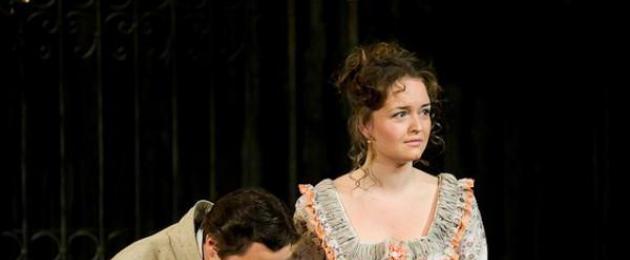A.N. Ostrovsky created an amazing gallery of Russian characters. Representatives of the merchant class became the main characters - from "domostroevsky" tyrants to real businessmen. The playwright's portrayals of women were no less vivid and expressive. Some of them looked like the heroines of J.S. Turgenev: they were just as brave and resolute, had warm hearts and never gave up their feelings. Below is an analysis of Ostrovsky's "Dowry", where the main character is a bright personality, different from the people who surrounded her.
History of creation
The analysis of Ostrovsky's "Dowry" should begin with the history of its writing. In the 1870s, Alexander Nikolayevich was an honorary judge in one county. Participation in lawsuits and familiarity with various cases gave him a new opportunity to search for topics for his works.
Researchers of his life and work suggest that the plot for this play was taken from his judicial practice. It was a case that made a lot of noise in the county - the murder of a local resident of his young wife. Ostrovsky began writing the play in 1874, but progress was slow. And only in 1878 the play was completed.
Actors and their brief description
The next point in the analysis of Ostrovsky's "Dowry" is a small description of the characters in the play.
Larisa Ogudalova is the main character. A beautiful and impressionable noblewoman. Despite her sensitive nature, she is a proud girl. Its main disadvantage is poverty. Therefore, her mother tries to find a rich groom for her. Larisa is in love with Paratov, but he leaves her. Then, out of desperation, she decides to marry Karandyshev.
Sergey Paratov is a nobleman who is over 30 years old. An unprincipled, cold and calculating person. Everything is measured in money. He is going to marry a rich girl, but does not tell Larisa about it.
Julius Kapitonych Karandyshev is a petty official who has little money. Vain, his main goal is to win the respect of others and impress them. Jealous of Larisa to Paratov.
Vasily Vozhevatov is a young rich merchant. I've known the main character since childhood. A cunning person without any moral principles.
Moky Parmenych Knurov is an elderly merchant, the richest man in the city. He likes the young Ogudalova, but he is a married man. Therefore, Knurov wants her to become his kept woman. Selfish, he cares only for his own interests.
Harita Ignatievna Ogudalova - Larisa's mother, widow. Cunning, she tries to profitably give her daughter in marriage so that they do not need anything. Therefore, he believes that any means are suitable for this.
Robinson is an actor, mediocrity, a drunkard. Friend of Paratov.

One of the points in the analysis of Ostrovsky's "Dowry" is a brief description of the plot of the play. The action takes place in the Volga city of Bryakhimov. In the first act, the reader learns from the conversation between Knurov and Vozhevatov that Sergei Paratov, a wealthy gentleman who loves to appear spectacularly in society, is returning to the city.
He left Bryakhimov so hastily that he did not say goodbye to Larisa Ogudalova, who was in love with him. She was in despair because of his departure. Knurov and Vozhevatov say that she is beautiful, smart and performs romances incomparably. Only her suitors shun her, because she is a dowry.
Realizing this, her mother constantly keeps the doors of the house open, in the hope that a rich groom will marry Larisa. The girl decides to marry a petty official, Yuri Kapitonych Karandyshev. During the walk, the merchants inform them of Paratov's arrival. Karandyshev invites them to a dinner party in honor of his fiancee. Julius Kapitonych arranges a scandal for the bride because of Paratov.
Meanwhile, Paratov himself, in a conversation with the merchants, says that he was going to marry the daughter of the owner of the gold mines. And Larisa is no longer interested in him, but the news of her marriage makes him think.

Larisa quarrels with her fiancé because she wants to leave with him for the village as soon as possible. Karandyshev, despite the constraint on funds, is going to give a dinner party. Ogudalova is having an explanation with Paratov. He accuses her of cheating and asks if she loves him. The girl agrees.
Paratov decided to humiliate Larisa's fiancé in front of the guests. He gets him drunk at dinner, and then persuades the girl to go on a boat trip with him. After spending the night with her, he tells her that he has a fiancee. The girl realizes that she is disgraced. She agrees to become the kept woman of Knurov, who won her in a dispute with Vozhevatov. But Yuri Karandyshev shot Larisa out of jealousy. The girl thanks him and says that she is not offended by anyone.
The image of Larisa Ogudalova
In the analysis of Ostrovsky's "Dowry" one should also consider the image of the main character. Larisa appeared before the reader as a beautiful, educated noblewoman, but without a dowry. And, finding herself in a society where the main measure is money, she was faced with the fact that no one takes her feelings seriously.
Possessing an ardent soul and a warm heart, she falls in love with the treacherous Paratov. But because of his feelings, he cannot see his true character. Larisa feels lonely - no one even tries to understand her, everyone uses her like a thing. But despite the subtle nature, the girl has a proud disposition. And just like all heroes, she is afraid of poverty. Therefore, she feels even more contempt for her fiancé.
In the analysis of Ostrovsky's "Dowry" it should be noted that Larisa does not have great fortitude. She does not decide to commit suicide or start living the life she wants. She accepts the fact that she is a thing and refuses to fight any further. Therefore, the groom's shot brought her peace, the girl was glad that all her suffering was over, and she found peace.

The image of Yuri Karandyshev
In the analysis of the play "Dowry" by Ostrovsky, one can also consider the image of the heroine's fiancé. Julius Kapitonych is shown to the reader as a small person who is important to earn the recognition of others. For him, a thing has value if rich people have it.
This is a proud man who lives for show and causes only contempt from others because of his pathetic attempts to be like them. Karandyshev, most likely, did not like Larisa: he understood that all men would envy him, because she was the dream of many. And he hoped to get the public recognition he so desired after their wedding. Therefore, Julius Kapitonich could not come to terms with the fact that she left him.

Comparison with Katerina
Comparative analysis of "Thunderstorm" and "Dowry" by Ostrovsky helps to find not only similarities, but also differences between the works. Both heroines are bright personalities, and their chosen ones are weak and weak-willed people. Katerina and Larisa have warm hearts and fall in love with men who match their imaginary ideal.
Both heroines feel lonely in society, and the internal conflict is heating up more and more. And this is where the differences come in. Larisa did not have the inner strength that Katerina had. Kabanova could not come to terms with life in a society where tyranny and despotism reigned. She rushed into the Volga. Larisa, realizing that for everyone she is a thing, cannot decide on such a step. And the girl does not even think about the fight - she just decides to live now like everyone else. Perhaps that is why the viewer immediately liked the heroine Katerina Kabanova.

Stage productions
In the analysis of Ostrovsky's drama "Dowry", it can be noted that, contrary to expectations, the performances failed. The viewer seemed bored with a story about a provincial girl who was deceived by a fan. Critics also did not like the acting: for them it was too melodramatic. And only in 1896 the play was staged again. And even then the audience was able to accept and appreciate it.
An analysis of Ostrovsky's work "Dowry" allows us to show what a serious psychological subtext the play has. How detailed the characters are. And, despite the sentimental scenes, the play belongs to the genre of realism. And her characters have replenished the gallery of Russian characters, masterfully described by A.N. Ostrovsky.
- In contact with 0
- Google Plus 0
- OK 0
- Facebook 0








